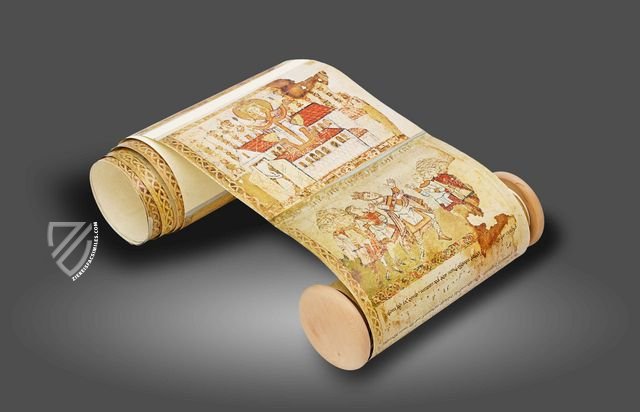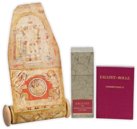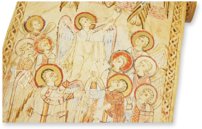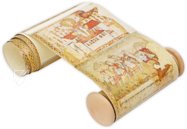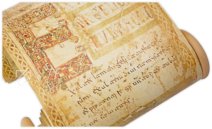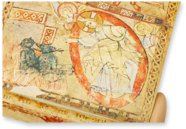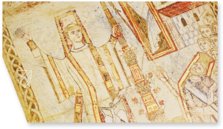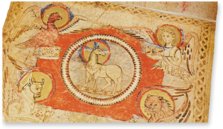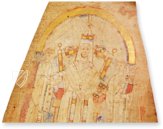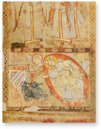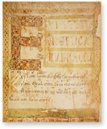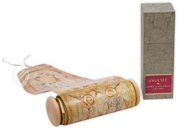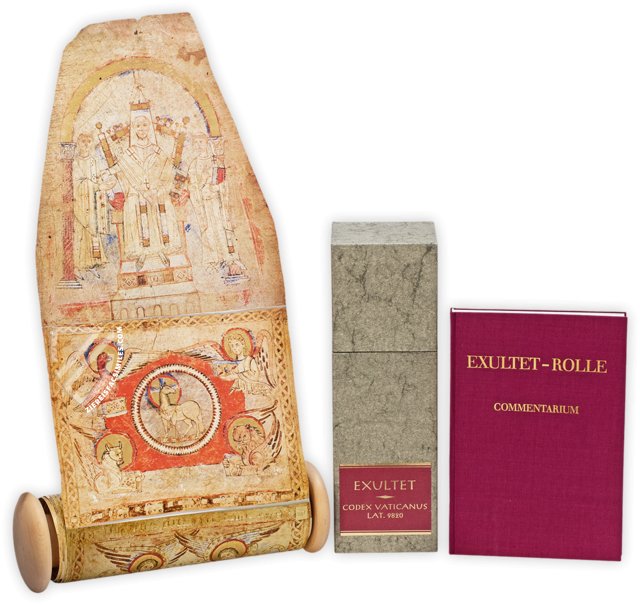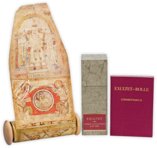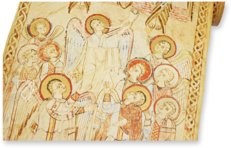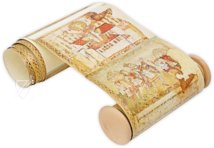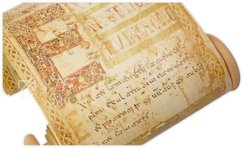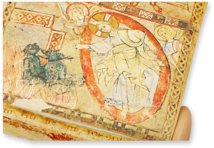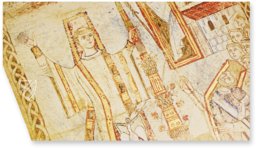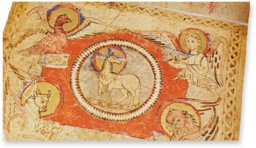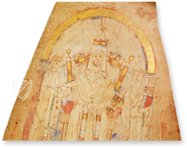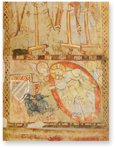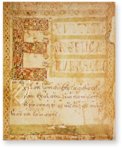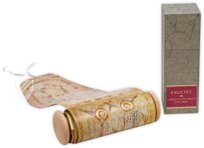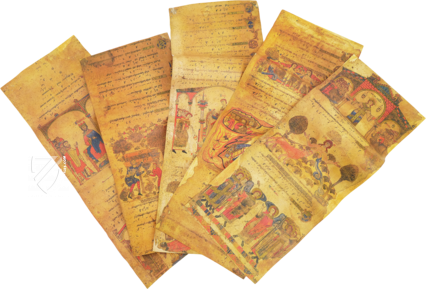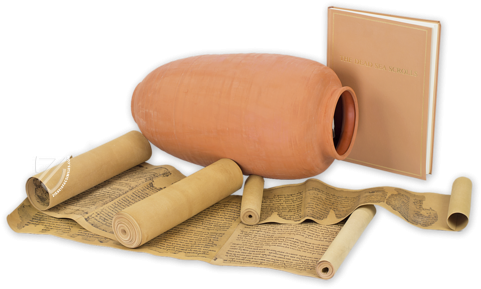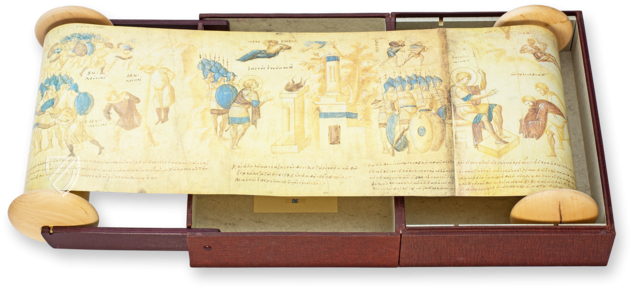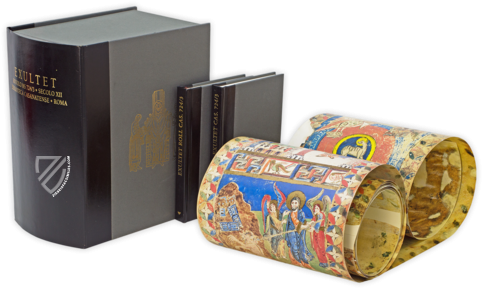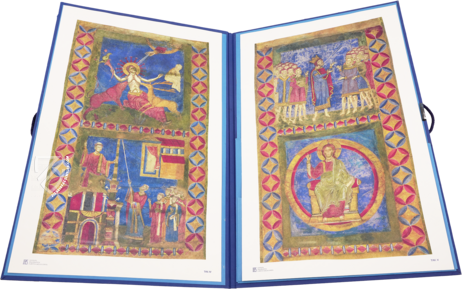Exultet Roll
(1,000€ - 3,000€)
“Exultet iam angelica turba caelorum...” – “Rejoice, choirs of angels...” – with these sung words, the deacon opens a new chapter in the Easter Vigil celebration: after the sorrowful and dolorous events of Good Friday, he sings the praises of the Easter candle, whose light symbolizes Christ's victory over death. What's special: the basis for this liturgy was an Exultet Roll like this one, which is over 7 meters long and constitutes the oldest surviving specimen of its kind. It comprises both text and melody for the liturgical celebration and is illuminated with striking images of Christian iconographies combining Byzantine, western, and classical motifs. At the time the manuscript was created, scrolls had long since fallen out of use in Europe, having been replaced by codices in the 4th century. However, this Exultet Roll was made in Benevento in southern Italy, where the stronger Byzantine influence was probably responsible for the decision to use the venerable form of an aesthetically appealing scroll.
Exultet Roll
The Exultet Scroll was used in Latin liturgy on the eve of Easter, when the deacon dressed in white sang the "Exultet" from it (named after the incipit exultet iam angelica turba caelorum … "now the heavenly crowd of angels shout for joy"). The Vatican manuscript constitutes the oldest surviving Exultet Scroll in the world and was made in the southern Italian city of Benevento, a cultural center in the early Middle Ages. The Exultet Scroll comprises both text and melody, as well as a picture cycle illustrating the song. These pictures and their wealth of styles bear splendid testimony to the creative power and great tradition of the schools of Benevento. The artists are distinguished by their high technical ability and skill as well as their imaginative eclecticism. They arranged stylistic, decorative, and iconographic elements in order to form an ensemble, using elements which are rooted both in classical antiquity and in Christian sources, integrating not only indigenous but also eastern and western motifs.
The Scroll: the First Book Form
As we know from many testimonies in art and literature, scrolls were used throughout antiquity instead of the bound book. Beginning in the 4th century, the codex triumphed and slowly but steadily replaced the scroll. In Christian literature, however, the codex was the preferred form right from the beginning. The scroll, in contrast, was only present following classical models, for the depiction of apostles, evangelists, prophets and saints. In liturgy, the scroll had not fallen into complete oblivion, as we learn from the Exultet Scroll inter alia. The reason might be the influence of Byzantium, as the Greek oriental Church had always been familiar with the scroll. As southern Italy and particularly Benevento were in regular contact with Byzantium on political and cultural levels, a certain inspiration to this effect seems possible. This development, however, remained limited to the region of Benevento where one appreciated the advantages of the scroll. By unrolling it in front of a wide public, everyone could clearly see in picture what was announced, in a poetic wording and an artfully composed melody, as the highlight of the liturgy on the eve of Easter.
The Adornment
The melody appears in Neume notation above each line of the sacred text, to guide the deacon in his song of praise. The images are artful pen drawings colored by one master in a multitude of colors and glittering gold. They show great love of detail and are surrounded throughout by decorative frames. Numerous motifs, such as jewels, pearls, interlace, palmettes, rosettes, and arcades imaginatively enliven the solemn system of frames.
Documenting the Early Medieval Easter Ceremony
The pictures accompanying the Exultet illustrate the song text according to the symbolical and metaphorical tradition of early Christendom. Some depictions display the Christian interpretation of pagan rites, for example when the resurrection of Christ in the annual Easter feast is associated with the coming of new life on earth thanks to Sol, the pagan God of the Sun. Nature celebrates the resurrection together with Jesus who is depicted in a splendid bright gloriole representing the light of the world, the sun of resurrection and salvation. Some pictures present a lively impression of the liturgical proceedings, reproducing it in complete detail. The Exultet Scroll is thus of essential importance for the history of liturgy and dogma, not the least for the documentary value of its illustrations.
Codicology
- Alternative Titles
- Exultet Rolle
- Size / Format
- 1 roll / 708.0 × 27.0 cm
- Origin
- Italy
- Date
- 981–987
- Epochs
- Style
- Genre
- Language
- Illustrations
- 14 miniatures with interlace frames, large decorative initials
Exultet Roll
Lamb of God and Evangelist Symbols
This fine miniature is a variation of the common “Christ in Majesty” – an image of an enthroned Christ in a mandorla (an almond-shaped frame) usually holding a codex, giving the sign of benediction, and surrounded by the Evangelist Symbols, which represent the authors of the Gospels of Matthew, Mark, Luke, and John. Represented by winged animals (a man, lion, ox, and eagle respectively), they are instead shown surrounding a white horse, which Christ rides to victory in the Book of Revelation.
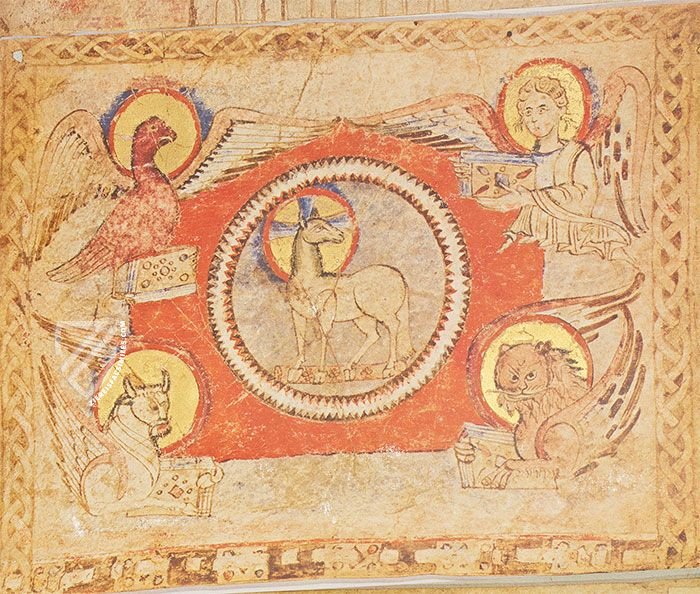
Exultet Roll
Seraphim and other Angels
The seraphim are angels belonging to the highest of the angelic choirs in heaven and described by the prophet Isaiah as surrounding God’s throne: “Above it stood seraphim; each one had six wings: with two he covered his face, with two he covered his feet, and with two he flew. And one cried to another and said: ‘Holy, holy, holy is the Lord of hosts; The whole earth is full of His glory!’” (Isa. 6:2–3)
This miniature shows two seraphim hovering above a host of angels dressed in rich robes trimmed in gold leaf, their bright blue colors faded by a millennium. In the center of the page, one of the angels raises up a trumpet and blows as though announcing the arrival of these divine beings while the others raise their hands in praise.
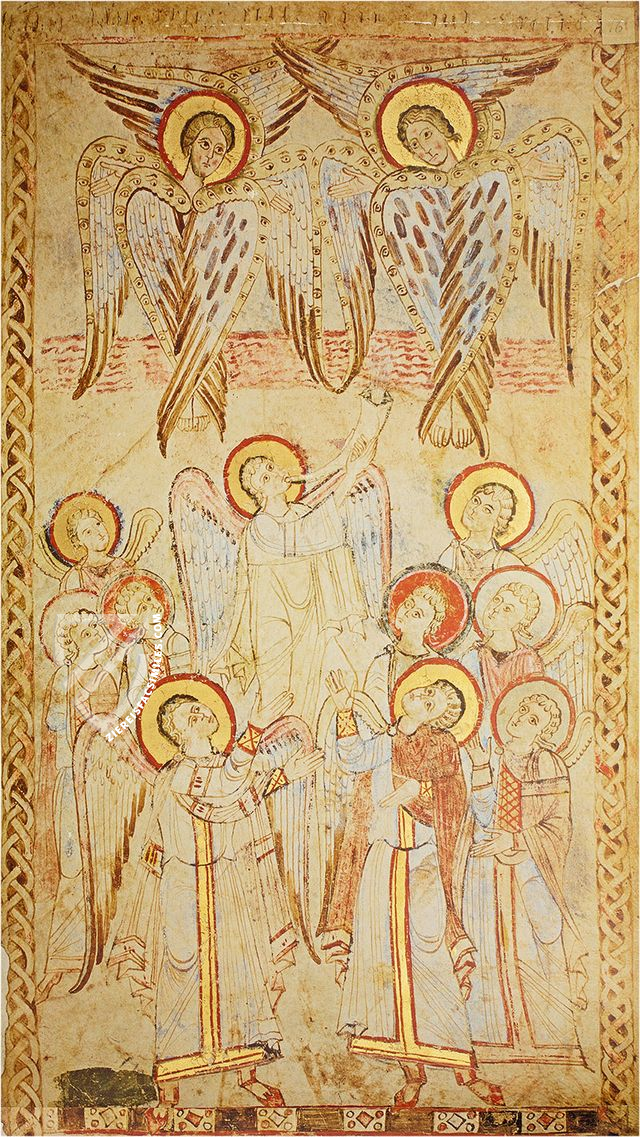
#1 Exultet Rolle
Language: German
The facsimile edition comes with a comprehensive scholarly commentary volume. Herbert Douteil provides a codicological analysis of the manuscript and places it in the context of the history of literature. Felix Vongrey explains the pictures in great detail and analyses them from an iconographic and art historical angle. The commentary volume is complete with an extensive bibliography and numerous comparative figures, making it a valuable companion to the manuscript.
Codicological and liturgy historical description by H. Douteil, Köln. Iconographical and art historical description by F. Vongrey, Lilienfeld. 126 pp. text, 1 fold-out plate and 53 illustrations on 32 plates.
(1,000€ - 3,000€)
- Treatises / Secular Books
- Apocalypses / Beatus
- Astronomy / Astrology
- Bestiaries
- Bibles / Gospels
- Chronicles / History / Law
- Geography / Maps
- Saints' Lives
- Islam / Oriental
- Judaism / Hebrew
- Single Leaf Collections
- Leonardo da Vinci
- Literature / Poetry
- Liturgical Manuscripts
- Medicine / Botany / Alchemy
- Music
- Mythology / Prophecies
- Psalters
- Other Religious Books
- Games / Hunting
- Private Devotion Books
- Other Genres
- Afghanistan
- Armenia
- Austria
- Belgium
- Belize
- Bosnia and Herzegovina
- China
- Colombia
- Costa Rica
- Croatia
- Cyprus
- Czech Republic
- Denmark
- Egypt
- El Salvador
- Ethiopia
- France
- Germany
- Greece
- Guatemala
- Honduras
- Hungary
- India
- Iran
- Iraq
- Israel
- Italy
- Japan
- Jordan
- Kazakhstan
- Kyrgyzstan
- Lebanon
- Liechtenstein
- Luxembourg
- Mexico
- Morocco
- Netherlands
- Palestine
- Panama
- Peru
- Poland
- Portugal
- Romania
- Russia
- Serbia
- Spain
- Sri Lanka
- Sweden
- Switzerland
- Syria
- Tajikistan
- Turkey
- Turkmenistan
- Ukraine
- United Kingdom
- United States
- Uzbekistan
- Vatican City
- A. Oosthoek, van Holkema & Warendorf
- Aboca Museum
- Ajuntament de Valencia
- Akademie Verlag
- Akademische Druck- u. Verlagsanstalt (ADEVA)
- Aldo Ausilio Editore - Bottega d’Erasmo
- Alecto Historical Editions
- Alkuin Verlag
- Almqvist & Wiksell
- Amilcare Pizzi
- Andreas & Andreas Verlagsbuchhandlung
- Archa 90
- Archiv Verlag
- Archivi Edizioni
- Arnold Verlag
- ARS
- Ars Magna
- ArtCodex
- AyN Ediciones
- Azimuth Editions
- Badenia Verlag
- Bärenreiter-Verlag
- Belser Verlag
- Belser Verlag / WK Wertkontor
- Benziger Verlag
- Bernardinum Wydawnictwo
- BiblioGemma
- Biblioteca Apostolica Vaticana (Vaticanstadt, Vaticanstadt)
- Bibliotheca Palatina Faksimile Verlag
- Bibliotheca Rara
- Boydell & Brewer
- Bramante Edizioni
- Bredius Genootschap
- Brepols Publishers
- British Library
- C. Weckesser
- Caixa Catalunya
- Canesi
- CAPSA, Ars Scriptoria
- Caratzas Brothers, Publishers
- Carus Verlag
- Casamassima Libri
- Centrum Cartographie Verlag GmbH
- Chavane Verlag
- Christian Brandstätter Verlag
- Circulo Cientifico
- Club Bibliófilo Versol
- Club du Livre
- CM Editores
- Collegium Graphicum
- Collezione Apocrifa Da Vinci
- Comissão Nacional para as Comemorações dos Descobrimentos Portugueses
- Coron Verlag
- Corvina
- CTHS
- D. S. Brewer
- Damon
- De Agostini/UTET
- De Nederlandsche Boekhandel
- De Schutter
- Deuschle & Stemmle
- Deutscher Verlag für Kunstwissenschaft
- DIAMM
- Droz
- E. Schreiber Graphische Kunstanstalten
- Ediciones Boreal
- Ediciones Grial
- Ediclube
- Edições Inapa
- Edilan
- Editalia
- Edition Deuschle
- Edition Georg Popp
- Edition Leipzig
- Edition Libri Illustri
- Editiones Reales Sitios S. L.
- Éditions de l'Oiseau Lyre
- Editions Medicina Rara
- Editorial Casariego
- Editorial Mintzoa
- Editrice Antenore
- Editrice Velar
- Edizioni Edison
- Egeria, S.L.
- Eikon Editores
- Electa
- Emery Walker Limited
- Enciclopèdia Catalana
- Eos-Verlag
- Ephesus Publishing
- Ernst Battenberg
- Eugrammia Press
- Extraordinary Editions
- Fackelverlag
- Facsimila Art & Edition
- Facsimile Editions Ltd.
- Facsimilia Art & Edition Ebert KG
- Faksimile Verlag
- Feuermann Verlag
- Folger Shakespeare Library
- Franco Cosimo Panini Editore
- Friedrich Wittig Verlag
- Fundación Hullera Vasco-Leonesa
- G. Braziller
- Gabriele Mazzotta Editore
- Gebr. Mann Verlag
- Gesellschaft für graphische Industrie
- Getty Research Institute
- Giovanni Domenico de Rossi
- Giunti Editore
- Graffiti
- Grafica European Center of Fine Arts
- Guido Pressler
- Guillermo Blazquez
- Gustav Kiepenheuer
- H. N. Abrams
- Harrassowitz
- Harvard University Press
- Helikon
- Hendrickson Publishers
- Henning Oppermann
- Herder Verlag
- Hes & De Graaf Publishers
- Hoepli
- Holbein-Verlag
- Houghton Library
- Hugo Schmidt Verlag
- Idion Verlag
- Il Bulino, edizioni d'arte
- ILte
- Imago
- Insel Verlag
- Insel-Verlag Anton Kippenberger
- Instituto de Estudios Altoaragoneses
- Instituto Nacional de Antropología e Historia
- Introligatornia Budnik Jerzy
- Istituto dell'Enciclopedia Italiana - Treccani
- Istituto Ellenico di Studi Bizantini e Postbizantini
- Istituto Geografico De Agostini
- Istituto Poligrafico e Zecca dello Stato
- Italarte Art Establishments
- Jan Thorbecke Verlag
- Johnson Reprint Corporation
- Josef Stocker
- Josef Stocker-Schmid
- Jugoslavija
- Karl W. Hiersemann
- Kasper Straube
- Kaydeda Ediciones
- Kindler Verlag / Coron Verlag
- Kodansha International Ltd.
- Konrad Kölbl Verlag
- Kurt Wolff Verlag
- La Liberia dello Stato
- La Linea Editrice
- La Meta Editore
- Lambert Schneider
- Landeskreditbank Baden-Württemberg
- Leo S. Olschki
- Les Incunables
- Liber Artis
- Library of Congress
- Libreria Musicale Italiana
- Lichtdruck
- Lito Immagine Editore
- Lumen Artis
- Lund Humphries
- M. Moleiro Editor
- Maison des Sciences de l'homme et de la société de Poitiers
- Manuscriptum
- Martinus Nijhoff
- Maruzen-Yushodo Co. Ltd.
- MASA
- Massada Publishers
- McGraw-Hill
- Metropolitan Museum of Art
- Militos
- Millennium Liber
- Müller & Schindler
- Nahar - Stavit
- Nahar and Steimatzky
- National Library of Wales
- Neri Pozza
- Nova Charta
- Oceanum Verlag
- Odeon
- Orbis Mediaevalis
- Orbis Pictus
- Österreichische Staatsdruckerei
- Oxford University Press
- Pageant Books
- Parzellers Buchverlag
- Patrimonio Ediciones
- Pattloch Verlag
- PIAF
- Pieper Verlag
- Plon-Nourrit et cie
- Poligrafiche Bolis
- Presses Universitaires de Strasbourg
- Prestel Verlag
- Princeton University Press
- Prisma Verlag
- Priuli & Verlucca, editori
- Pro Sport Verlag
- Propyläen Verlag
- Pytheas Books
- Quaternio Verlag Luzern
- Reales Sitios
- Recht-Verlag
- Reichert Verlag
- Reichsdruckerei
- Reprint Verlag
- Riehn & Reusch
- Roberto Vattori Editore
- Rosenkilde and Bagger
- Roxburghe Club
- Salerno Editrice
- Saltellus Press
- Sandoz
- Sarajevo Svjetlost
- Schöck ArtPrint Kft.
- Schulsinger Brothers
- Scolar Press
- Scrinium
- Scripta Maneant
- Scriptorium
- Shazar
- Siloé, arte y bibliofilia
- SISMEL - Edizioni del Galluzzo
- Sociedad Mexicana de Antropología
- Société des Bibliophiles & Iconophiles de Belgique
- Soncin Publishing
- Sorli Ediciones
- Stainer and Bell
- Studer
- Styria Verlag
- Sumptibus Pragopress
- Szegedi Tudomànyegyetem
- Taberna Libraria
- Tarshish Books
- Taschen
- Tempus Libri
- Testimonio Compañía Editorial
- Thames and Hudson
- The Clear Vue Publishing Partnership Limited
- The Facsimile Codex
- The Folio Society
- The Marquess of Normanby
- The Richard III and Yorkist History Trust
- Tip.Le.Co
- TouchArt
- TREC Publishing House
- TRI Publishing Co.
- Trident Editore
- Tuliba Collection
- Typis Regiae Officinae Polygraphicae
- Union Verlag Berlin
- Universidad de Granada
- University of California Press
- University of Chicago Press
- Urs Graf
- Vallecchi
- Van Wijnen
- VCH, Acta Humaniora
- VDI Verlag
- VEB Deutscher Verlag für Musik
- Verlag Anton Pustet / Andreas Verlag
- Verlag Bibliophile Drucke Josef Stocker
- Verlag der Münchner Drucke
- Verlag für Regionalgeschichte
- Verlag Styria
- Vicent Garcia Editores
- W. Turnowski Ltd.
- W. Turnowsky
- Waanders Printers
- Wiener Mechitharisten-Congregation (Wien, Österreich)
- Wissenschaftliche Buchgesellschaft
- Wissenschaftliche Verlagsgesellschaft
- Wydawnictwo Dolnoslaskie
- Xuntanza Editorial
- Zakład Narodowy
- Zollikofer AG

